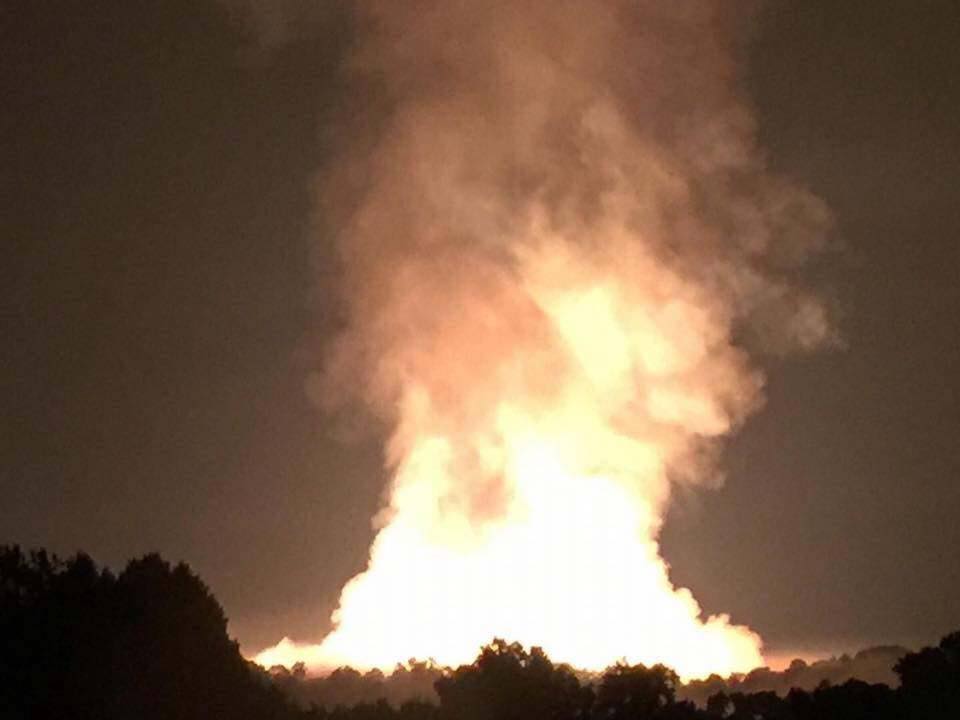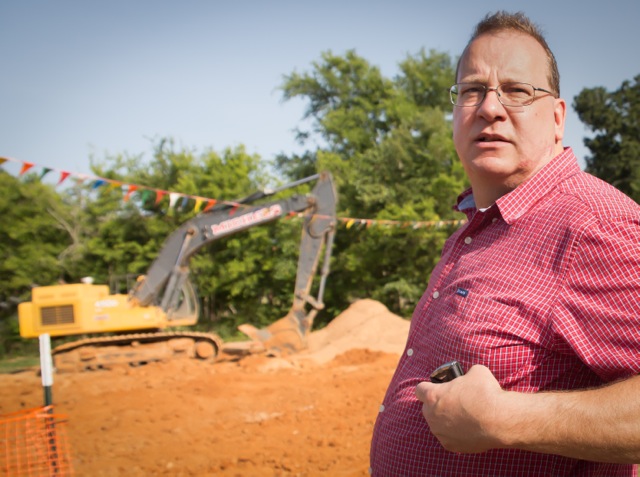This morning, residents of Marshall County, West Virginia, awoke at 4:15 a.m. to a major natural gas rupture and explosion on TransCanada’s Leach XPress pipeline on Nixon Ridge — a quickly built pipeline only half a year old.
The fire was visible for miles, local TV news reported. Police warned anyone who could see the flames to evacuate — and the Emergency Management Agency director of neighboring Ohio County said officials had received dozens of 911 calls from locals able to see the fire, which was extinguished roughly four hours later. The blast was so powerful that one resident told a local CBS affiliate it felt like a tornado was passing through.
No one was injured, and no property damage was reported, TransCananda said in a statement released today, adding that the cause of the explosion was not yet determined.
The Leach XPress pipeline is just six months old, having been put into service on January 1, 2018.
At the time, TransCanada emphasized that it was built quickly — but safely. “Leach XPress was done in less than a year,” Scott Castleman, manager of U.S. Gas Communications for TransCanada, said in a January statement.
“We’re looking forward to generations of safe operations,” he added. “This is truly a best-in-class pipeline and we look forward to many years of safe, reliable, and efficient operation on behalf of our customers.”
Leach XPress is the first in a series of major TransCanada pipeline construction projects — and part of a larger sprint to build out oil and gas pipelines nationwide, spurred by an urgent push to get shale gas and oil to market.
“This is our first major pipeline in our growth portfolio,” Castleman said in January. “There’s currently about 8 and a half billion dollars in pipeline projects in the works for the U.S. and TransCanada.”
Leach XPress, a 36-inch-diameter pipeline, went into immediate heavy service after it was built. Market research firm Genscape Inc. “said in a note to clients on Thursday that the Leach XPress segment has been flowing at or just above its operational capacity through May,” Natural Gas Intelligence reported.
The 160-mile, $1.6 billion dollar pipeline project is designed to carry 1.5 billion cubic feet of natural gas a day, moving it from the Marcellus and Utica shales down to the Southeast and Gulf Coast regions. Leach XPress runs from Marshall County, about 70 miles from Pittsburgh, Pennsylvania, into Ohio, and its gas then flows into the 12,000-mile Columbia Gas Transmission pipeline system.
Sprint to Build Pipelines
TransCanada also received U.S. Federal Energy Regulatory Commission (FERC) approval for two other pipelines, the company announced on January 1, the same day that Leach XPress went into service.
The company plans to spend $3.2 billion to build the 171-mile Mountaineer XPress and the smaller Gulf XPress pipeline in Appalachia and intends to have those pipelines up and running by the end of this year.
In March, FERC rejected a request to suspend construction of these projects from three environmental groups, the Allegheny Defense Project, the Ohio Valley Environmental Coalition, and the Sierra Club, finding that their “generalized claims of environmental harm, however, do not constitute sufficient evidence of irreparable harm that would justify a stay.”
This year, pipeline companies plan to lay 14,657 miles of pipeline worldwide — roughly double the amount finished in 2017, an Oil & Gas Journal report found. Over 81 percent of those pipes will carry natural gas, the same fossil fuel in today’s pipeline blast.
And they’re planning to do it at starkly reduced costs of $5.94 million per mile, down from $7.65 million.
Meanwhile, whistleblowers at numerous pipeline companies have raised red flags about the impacts of rushed construction — including TransCanada.
DeSmog has previously reported numerous concerns raised by former TransCanada engineer Evan Vokes about construction problems and cut corners at TransCanada’s Keystone 1 and other pipelines.
“TransCanada keeps insisting the Keystone XL pipeline will be the safest pipeline ever built despite irrefutable evidence to the contrary,” Vokes, who was fired after ringing alarm bells internally, testified at a State Department hearing in Nebraska in April 2013. “In fact they are building the southern portion of the Keystone XL to the lowest permissible standards, just as they have the Keystone 1 and the Bison Pipeline.”
Former TransCanada engineer-turned-whistleblower Evan Vokes at a TransCanada construction site in Texas. ©2013 Julie Dermansky
The cause of the blast today is not yet clear.
In November, the Keystone pipeline spilled roughly 210,000 gallons of bitumin from tar sands in northeast South Dakota, a spill that came on the heels of other spills on that same line in 2016 and 2011.
Separately, in October, an accident at a TransCanada meter station in Ohio killed a maintenance worker following a leak of pressurized gas that did not ignite.
The Calgary-based company’s operations in the U.S. are massive, especially following its acquisition of the Columbia Gas pipeline network two years ago. It operates over 56,000 miles of pipes, which can be found in virtually all of the major North American gas-producing areas.
“Once we’re done, we’ll be the only company in North America that can move a molecule of gas right from Northern Alberta through the Midwest and to the Gulf Coast and into Mexico City,” President and CEO Russell K. Girling said in a July 2017 video commemorating the acquisition. “We are now moving one in every four molecules [of gas] that crosses this continent, and we are an extremely important part of the economic fabric of Canada, Mexico, and the United States.”
“We truly are the North American natural gas transmission company,” Girling added.
Main image credit: Marshall County Homeland Security & Emergency Management, via Facebook
Subscribe to our newsletter
Stay up to date with DeSmog news and alerts







